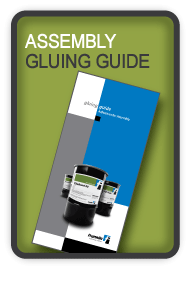Assembly
Franklin Adhesives & Polymers offers a full line of superior-quality assembly glues formulated to meet the demands of your woodworking operation. Many of our products are designed for specific applications including hot melt, finger jointing and automatic dowel insertion. Our products offer varying degrees of open time, cure time and viscosity to match specific application requirements. To determine an appropriate product option for your application, please refer to our product selector.
The term "assembly gluing" covers a wide range of joint types. Most of these involve gluing side grain to side or end grain. Some joint types include dowel, mortise and tenon, dovetail and miter. To obtain best results in using our adhesives in assembly applications, please follow the below guidelines.
Technical Leadership

Our technical team has compiled the information below to obtain the best results when using our adhesives in various assembly applications.
Spread
Adhesive is generally applied by plastic squeeze bottles or brush. It is important to get a uniform coating over the entire gluing surface. In dowel assemblies, the sides of the dowel hole should be evenly coated. The dowel forces glue up the side of the dowel.
Assembly time
Assembly time can vary greatly depending on the adhesive used, glue spread, porosity and moisture content of the gluing stock, environmental conditions, etc. Generally accepted assembly times are less than five minutes.
Minimum temperature
Curing temperatures should be higher than the minimum use temperature of the adhesive. This includes the temperature of the stock to be glued as well as the air and adhesive temperatures.
Joint preparation
Joints should be cut accurately with sharp tools. Joints should fit snugly when assembled and clamped. Adhesives should not be expected to act as gap fillers. Conversely, too tight of a joint may cause the adhesive to be scraped away from the gluing surface during assembly. Dull cutting tools will cause glazed or burnished surfaces, preventing adhesive penetration.
Clamping
A variety of clamps and clamping systems are available for assembly joints. Enough clamping pressure is recommended to provide a thin glue line along the entire surface of the joint. Direct contact of the gluing surfaces is required to obtain maximum strength.
Clamp time
Clamp time is dependent on the adhesive used, species and moisture content of the stock, environmental factors and glue line thickness. Clamp times can range from a few minutes to more than an hour, depending on the above factors. Clamp times should be determined under plant conditions.
Additional information on assembly gluing can be found in the full version of our Assembly Gluing Guide or by contacting our technical support team. For more information about gluing equipment, please refer to our resources link.
ASSEMBLY PRODUCTS:
Advantage 405 - Highly water resistent; has a low minimum use temperature
Assembly 65 - A very versatile, high solids adhesive for good gap filling; it is widely used for assembly applications and general cabinetry.
Assembly 161 - Specifically designed for use with automatic doweling equipment; its low viscosity of 160cps allows for appropriate flow through narrow feed lines and injectors.
Assembly Clear - Cost effective and fast setting adhesive that creates a translucent glue line when dried
ReacTITE 6010 - Ideal for wood assembly applications and bonding decorative moldings where longer open times are desired
ReacTITE 6025 - Ideal for corner blocks, base rail and miter joints, and bonding decorative molding (dentil, rope, fret work, and ornamental rosette)
ReacTITE 8043 - Ideal for high moisture content wood and general assembly where a medium open time is desired